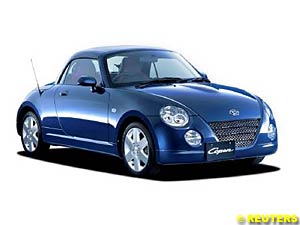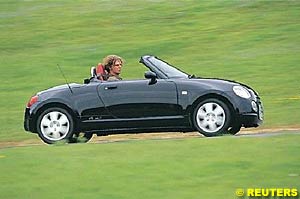

Automotive News and Reviews for the Petrolhead
Reuters Motoring Commentator
In this week's issue:
- Crowded Fight for Europe's Car Market
- Noddy Car
- GM Plans to Drive Rear-Wheel
Volkswagen's new Golf and Opel's new Astra, their brands' best-selling models, will fight for an eroding market share as Europe's biggest car segment is chipped away by small lifestyle vehicles and Asian rivals.
VW and General Motors Corp's Opel have pinned next year's market share and profit hopes on the two cars, which get their first exposure to buyers at this week's Frankfurt auto show. But the time when carmakers could churn out just a couple of staple cars in the lower-middle segment, which accounts for about one third of European sales, and count on big profits, is gone.
Models aimed at these buyers are coming thick and fast with the Golf and Astra being launched almost simultaneously and a fresh Ford Focus due next year. Renault's Megane turned heads at car shows just a year ago with its angular tail, but it could quickly look dated as competition intensifies and companies are forced to refresh core models more frequently.
Some carmakers in the European sector are giving optimistic forecasts, say experts, and as the so-called "C" segment is so important, it will see an especially tough fight for share.
"If you put all the companies sales projections together you get 135 percent market share so there are going to be some losers," said Arther Maher of UK-based JDPower LMC.
He expects about 4.4 million vehicles to be sold in the low-mid segment this year, including minivans and multi-purpose vehicles, rising to 4.5 million next year and 4.75 million in 2005, helped also by new models and stronger demand.
Variants
While the segment overall is not shrinking, the traditional models will take a smaller slice of the pie due to a wide range of new variants.
A shift in European consumer tastes to life-style cars -- mini multi purpose vehicles and minivans including VW's Touran, Ford's CMax, Opel's Zafira and Renault's new Scenic -- are expected to cannibalise sales of the traditional hatchback models.
"The question is to what extent they make new sales and to what extent there is a substitution effect," said Maher.
Experts reckon the minivan-type vehicles, called "minicabs" by some makers, will account for about a third of the low-mid segment for those companies that have one, although the Scenic accounts for nearer half of that segment for Renault.
GM Europe chief Mike Burns acknowledges the traditional low-middle class car segment has shrunk due to the popularity of the taller, more spacious minicabs, such as the Zafira.
Sales of the Astra peaked at about 500,000 units before the introduction of Opel's Zafira and at some 400,000 vehicles afterwards.
Japanese Designs
The other threat to Europe's stalwarts comes from Asia. Japanese carmakers, with efficient plants and processes, can offer well-equipped cars at extrememly competitive prices and have been snatching market share from the domestic players with smart new designs that appeal to European tastes.
In the first half of this year Japanese makers saw their market share rise to 12.3 percent from 11.3 percent a year ago in a contracting market, helped by models such as the highly successful Mazda 3, Honda Civic and Toyota Corolla.
"Their success is not exclusively in the C segment, but volume cars are their strength so it does include the lower to mid end vehicles as well as some smaller ones like the Nissan Micra and some larger," said one executive at a rival automaker.
Some European auto executives argue brand loyalty among carmaking nations here, particularly in Germany, France and to some extent Italy, will protect the region from an onslaught on the scale of the United States where Toyota last month overtook Chrysler as the third best seller in the market.
But one European car executive said he saw no reason in the long run to stop the Japanese posing as much of a threat as in Europe as they do in the U.S. .
And the Japanese are now moving to embrace diesel engines, which account for over a quarter of European car sales and is expected to grow. Honda presented a diesel version of its popular Accord saloon at the Frankfurt show, its first own-make diesel car. It will take the technology to other models.
"Without diesel, we cannot satisfy our customers .. and without diesel it is tough to grow in Europe," Honda Europe president Minoru Harada told Reuters at the show.
I must declare an interest: the moment I climb into the Daihatsu Copen I am transformed into Noddy. There's not much I can do about it. The fact is there for all to see the moment the metallic roof comes down. Bring on the winter...
The Copen is a tiny car, which thankfully means there's no room for Big Ears. The narrow width of the car would turn Big Ears into Big Ear the first time the Copen passed by an oncoming car. It is just as well that Big Ears couldn't come along for the ride in any case, as my heterosexuality is already challenged quite enough whenever I drive a small open-top.
Japanese miniaturisation doesn't simply extend to the car's dimensions either, but also the engine size. K-Class cars must also have an engine no larger than 660cc. The Copen makes the grade with a cubic centimetre to spare.
It has plenty of competition now. It's not pricey enough to take on the MX-5, but the established Peugeot 206CC and the recently revamped Fiat Barchetta lie in wait, as do the newer Ford Streetka, Citroen C3 Pluriel, VW Beetle Cabrio and Smart Roadster. Only the MX-5 is arguably more fun.
Unholy Revs
Don't think for a minute that the tiny engine turns the Copen into a snail. The car isn't exactly hot as far as straight-line performance goes, but Daihatsu has plenty of experience of making tiny engines fun, brisk, frantic and durable. And the K-Class regulations say nothing against fitting a turbo!
Forget the performance figures on paper. Official figures don't exist yet in any case, but the Copen has unofficially clocked a 0-60mph time of a shade under ten seconds, with a top speed of just over 100mph. Not bad, but not a sports car. However, the Copen absolutely demands that it should be driven at high revs and it will happily reach a red line rev limit of 8,500rpm.
So you always feel as if you're doing about 20mph more than the speedo tells you you're doing. That's if you can concentrate on looking at the speedo, given that the high-rev buzziness and turbo whistle are almost cacophonous. Quite simply, you'd be hard pushed to have more fun in a car at road legal speeds.
Anyone who's sat behind the wheel of a go kart will know what I mean. All this does make the task of driving down a motorway rather onerous. Admittedly, the test car was a Japanese-spec one and UK cars will have a higher fifth gear to bring the revs down and fuel economy up.
Adding to the fun factor is the extraordinary grip that belies the Copen's dinky toy looks. I had the opportunity to take the Copen on a test track, and you can literally plummet around corners without losing the back end. The front-engined, front wheel drive layout helps with stability here even if it doesn't add precision to the handling. But the steering is accurate and direct - there's no great weight to throw about - and the brakes are sharp. The manual gearchange is precise, too. There will also be an automatic dual mode option.
Comfortably Numb
The Japanese-spec car was also fitted with an optional sports suspension. We suspect the standard suspension will be quite ?sporty' enough, as the ride quality was about as smooth as a sea dog's chin. The very short wheelbase does have trouble coping with many road surfaces.
On the other hand, the SLK-style electric folding metallic roof is a doddle to use, a masterpiece of miniaturisation. The low seating position makes the car hard to enter and exit. But on the other hand it does free up legroom. The seats are comfortable, and generous equipment includes twin airbags and ABS, electric windows and mirrors, air-conditioning, CD player and alloy wheels.
This is no stripped-out go kart. If you can get a car delivered this year, it will also come with free heated leather seats, leather door trim and Momo steering wheel. But that may be hard as only 1000 will be available each year and the car goes on sale in November.
The Copen is a great car, fun to drive and hard to beat as an attention-grabber. The price isn't excessive either, but whatever you do, make sure you have another car as backup for anytime you need to do anything useful.
General Motors on Monday said it was considering a new line of rear-wheel-drive cars for markets around the world, including Europe and the United States.
The vehicles would be built off an all-new global "platform," or group of common parts, that were used to construct a concept version of a mid-size Opel luxury sedan unveiled Monday. The new platform, which may be several years away from production, would plug some gaping holes in GM's vehicle line-up and give it the chance to compete for a richer class of buyers.
"We have a couple of brands where we think this kind of platform could apply, especially in the U.S.," GM Chairman Rick Wagoner told reporters at the unveiling before the Frankfurt motor show. "I think it makes sense, increasingly, for a product of this size...to sell it on several continents."
GM has for years pursued a strategy of building as many models as possible off a small number of platforms. That allows it to spread engineering, parts and tooling costs over a larger number of vehicles.
While GM has been successful in platform sharing for trucks, and has begun consolidating its car models onto fewer platforms, it has lacked a high-volume, moderately priced, rear-wheel-drive car platform. That has left the market open for luxury automakers such as BMW and DaimlerChrysler's Mercedes brand to sell less expensive models and grow market share.
When GM Vice Chairman Bob Lutz decided to resurrect the Pontiac GTO muscle car, he was forced to import a rear-wheel drive car from GM's Australian unit and fit it for the U.S. market. Lutz has said he wants to build the next-generation GTO in the United States, after GM develops a new rear-wheel drive car platform.
Wagoner said the problem was most acute in Europe, where Opel has traditionally sold a larger rear-wheel-drive sedan that hasn't always fared so well. GM Europe's sales are up this year, but it's still forecast to post profits between breakeven and a loss of $200 million as pricing pressures mount.
"As the so-called premium brands have come downmarket, that has put some pressure on us, so we need to find ways to push up," he said.
The concept car, the Opel Insignia, bears some resemblance to the Chrysler Airflite, another rear-wheel-drive concept unveiled earlier this year. Wagoner said the Insignia was designed as a head-on competitor to the BMW 5-Series sedans, and was meant to make Opel more of a luxury brand, leaving the cut-rate European car market to GM's Korean affiliate, Daewoo.
"Daewoo is going to cover more of the value price points," Wagoner said, "and I think over time that's going to let us use more of the Opel product development capabilities to move up in line a little more consistently with its German heritage, and to be quite honest, a little more consistent with its German cost structure."
![]() Crowded Fight for Europe's Car Market
Crowded Fight for Europe's Car Market
![]() Noddy Car
Noddy Car
 At nearly a foot shorter than a Ford Ka, the Copen is a Japanese K-Class car, one of the miniature go-karts so loved in Japan. The K-Class, incidentally gets its name from the Japanese "kei", meaning light. It is a successor to cars like the Suzuki Cappuccino and the Honda Beat that you might have seen darting around during the Nineties.
At nearly a foot shorter than a Ford Ka, the Copen is a Japanese K-Class car, one of the miniature go-karts so loved in Japan. The K-Class, incidentally gets its name from the Japanese "kei", meaning light. It is a successor to cars like the Suzuki Cappuccino and the Honda Beat that you might have seen darting around during the Nineties.
 You've probably got the impression by now that the Copen isn't exactly a car for those who like comfortable driving. The steering wheel is too big and the cabin is narrow, hard to get in and out of and dated. The stereo is all but inaudible on the motorway. Also detracting from a feeling of comfort is the worrying fact that the seat backs are taller than the anti-roll bars. Storage space is negligible - a small area behind the seats and a tiny boot that will only take a "soft sports bag" when the roof is down.
You've probably got the impression by now that the Copen isn't exactly a car for those who like comfortable driving. The steering wheel is too big and the cabin is narrow, hard to get in and out of and dated. The stereo is all but inaudible on the motorway. Also detracting from a feeling of comfort is the worrying fact that the seat backs are taller than the anti-roll bars. Storage space is negligible - a small area behind the seats and a tiny boot that will only take a "soft sports bag" when the roof is down.
![]() GM Plans to Drive Rear-Wheel
GM Plans to Drive Rear-Wheel
© 1995-2005 Kaizar.Com, Inc. . This service is provided under the Atlas F1 terms and conditions.
|
Volume 9, Issue 37
Atlas F1 Exclusive
Interview with Sam Michael
Fisichella: Through the Visor
Season in the Sun
GP Preview
2003 Italian GP Preview
Italy Facts & Stats
Columns
The Fuel Stop
Rear View Mirror
Bookworm Critique
On the Road
Elsewhere in Racing
The Weekly Grapevine
> Homepage |